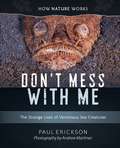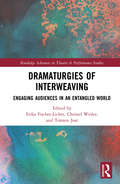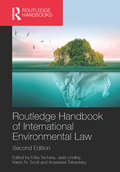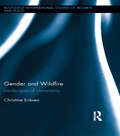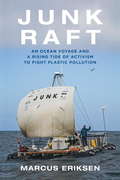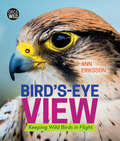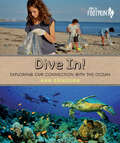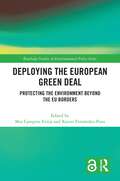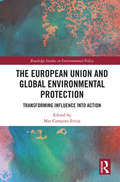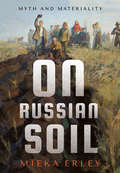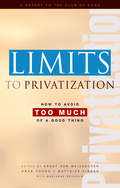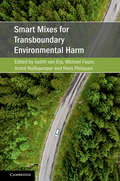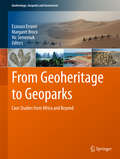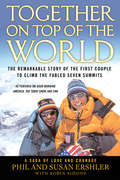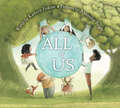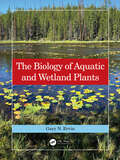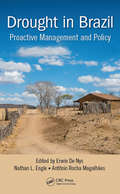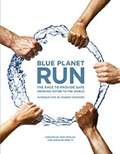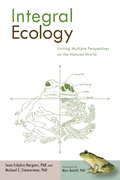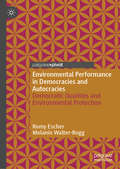- Table View
- List View
Don't Mess With Me: The Strange Lives Of Venomous Sea Creatures (How Nature Works #0)
by Paul Erickson Andrew MartinezThe role of venoms in nature … and in human medicine Why are toxins so advantageous to their possessors as to evolve over and over again? What is it about watery environments that favors so many venomous creatures? Marine biologist Paul Erickson explores these and other questions with astounding images from Andrew Martinez and other top underwater photographers. GREAT for teaching STEM Marine Biology Scorpions and brown recluse spiders are fine as far as they go, but if you want daily contact with venomous creatures, the ocean is the place to be. Blue-ringed octopi, stony corals, sea jellies, stonefish, lionfish, poison-fanged blennies, stingrays, cone snails, blind remipedes, fire urchins—you can choose your poison in the ocean. Venoms are often but not always defensive weapons. The banded sea krait, an aquatic snake, wriggles into undersea caves to prey on vicious moray eels, killing them with one of the world’s most deadly neurotoxins, which it injects through fangs that resemble hypodermic needles.
Dramaturgies of Interweaving: Engaging Audiences in an Entangled World (Routledge Advances in Theatre & Performance Studies)
by Erika Fischer-Lichte, Christel Weiler and Torsten JostDramaturgies of Interweaving explores present-day dramaturgies that interweave performance cultures in the fields of theater, performance, dance, and other arts. Merging strategies of audience engagement originating in different cultures, dramaturgies of interweaving are creative methods of theater and art-making that seek to address audiences across cultures, making them uniquely suitable for shaping people’s experiences of our entangled world. Presenting in-depth case studies from across the globe, spanning Australia, China, Germany, India, Iran, Japan, Singapore, Taiwan, Vietnam, the US, and the UK, this book investigates how dramaturgies of interweaving are conceived, applied, and received today. Featuring critical analyses by scholars—as well as workshop reports and artworks by renowned artists—this book examines dramaturgies of interweaving from multiple locations and perspectives, thus revealing their distinct complexities and immense potential. Ideal for scholars, students, and practitioners of theater, performance, dramaturgy, and devising, Dramaturgies of Interweaving opens up an innovative perspective on today’s breathtaking plurality of dramaturgical practices of interweaving in theater, performance, dance, and other arts, such as curation and landscape design.
Routledge Handbook of International Environmental Law
by Erika Techera; Jade Lindley; Karen N. Scott; Anastasia TelesetskyThis book critically explores the legal tools, concepts, principles and instruments, as well as cross-cutting issues, that comprise the field of international environmental law. Commencing with foundational elements, progressing on to discrete sub-fields, then exploring regional cooperative approaches, cross-cutting issues and finally emerging challenges for international environmental law, it features chapters by leading experts in the field of international environmental law, drawn from a range of countries in order to put forward a truly global approach to the subject. The book is split into five parts: • The foundations of international environmental law covering the principles of international environmental law, standards and voluntary commitments, sustainable development, issues of public participation and environmental rights and compliance, state responsibility, liability and dispute settlement. • The key instruments and governance arrangements across the most critical areas of international environmental law: biodiversity, wildlife, freshwater, forestry and soils, fisheries, marine pollution, chemicals and waste, air and atmospheric pollution and climate change. • Crucial developments in seven distinct regions of the world: Africa, Europe, North America, Latin America, South East Asia, the polar regions and small island states. • Cross-cutting issues and multidisciplinary developments, drawing from multiple other fields of law and beyond to address human rights and Indigenous rights, war and armed conflict, trade, financing, investment, criminology, technology and energy. • Contemporary challenges and the emerging international environmental law regimes which address these: the changing climate, forced migration, marine plastic debris and future directions in international environmental law. Containing chapters on the most critical developments in environmental law in recent years, this comprehensive and authoritative book makes for an essential reference work for students, scholars and practitioners working in the field.
Gender and Wildfire: Landscapes of Uncertainty (Routledge International Studies of Women and Place #13)
by Christine EriksenIn pursuit of lifestyle change, affordable property, and proximity to nature, people from all walks of life are moving to the wildland-urban interface. Tragic wildfires and a predicted increase in high fire danger weather with climate change have triggered concern for the safety of such amenity-led migrants in wildfire-prone landscapes. This book examines wildfire awareness and preparedness amongst women, men, households, communities and agencies at the interface between city and beyond. It does so through an examination of two regions where wildfires are common and disastrous, and where how to deal with them is a major political issue: southeast Australia and the west coast United States. It follows women’s and men’s stories of surviving, fighting, evacuating, living and working with wildfire to reveal the intimate inner workings of wildfire response – and especially the culturally and historically distinct gender relations that underpin wildfire resilience. Wildfire is revealed as much more than a "natural" hazard – it is far from gender-neutral. Rather, wildfire is an important means through which traditional gender roles and power relations are maintained despite changing social circumstances. Women’s and men’s subjectivities are shaped by varying senses of inclusion, exclusion, engagement and disengagement with wildfire management. This leads to the reproduction of gender identities with clear ramifications for if, how and to what extent women and men prepare for wildfire.
Junk Raft: An Ocean Voyage and a Rising Tide of Activism to Fight Plastic Pollution
by Marcus EriksenAn exciting account of an activist scientist’s unorthodox fight in the growing movement against plastic marine pollution and of his expedition across the Pacific on a home-made “junk raft”News media brought the “Great Pacific Garbage Patch”—the famous swirling gyre of plastic pollution in the ocean—into the public consciousness. But when Marcus Eriksen cofounded the 5 Gyres Institute with his wife, Anna Cummins, and set out to study the world’s oceans with hundreds of volunteers, they discovered a “plastic smog” of microscopic debris that permeates our oceans globally, defying simple clean-up efforts. What’s more, these microplastics and their toxic chemistry have seeped into the food chain, threatening marine life and humans alike.Far from being a gloomy treatise on an environmental catastrophe, though, Junk Raft tells the exciting story of Eriksen and his team’s fight to solve the problem of plastic pollution. A scientist, activist, and inveterate adventurer, Eriksen is drawn to the sea by a desire to right an environmental injustice. Against long odds and common sense, he and his co-navigator, Joel Paschal, construct a “junk raft” made of plastic trash and set themselves adrift from Los Angeles to Hawaii, with no motor or support vessel, confronting perilous cyclones, food shortages, and a fast decaying raft.As Eriksen recounts his struggles to keep afloat, he immerses readers in the deep history of the plastic pollution crisis and the movement that has arisen to combat it. The proliferation of cheap plastic products during the twentieth century has left the world awash in trash. Meanwhile, the plastics industry, with its lobbying muscle, fights tooth and nail against any changes that would affect its lucrative status quo, instead defending poorly designed products and deflecting responsibility for the harm they cause.But, as Eriksen shows, the tide is turning in the battle to save the world’s oceans. He recounts the successful efforts that he and many other activists are waging to fight corporate influence and demand that plastics producers be held accountable. Junk Raft provides concrete, actionable solutions and an empowering message: it’s within our power to change the throw-away culture for the sake of our planet.
Bird's-Eye View: Keeping Wild Birds in Flight (Orca Wild #4)
by Ann ErikssonWild birds are everywhere, from the dry deserts to the icy poles. We see them soaring overhead, paddling across water, flitting through trees, pecking at the ground or our backyard bird feeders and singing from fence posts. Birds contribute to the health of the planet and provide pleasure for millions of people, but wild birds are in trouble. Today, almost 200 bird species are critically endangered. They are threatened by habitat loss, invasive species, climate change, pesticides, plastics in the environment, human-made structures and other animals. Bird’s Eye View looks at why wild birds are important, why they need help and what young people all over the world are doing and can do to give wild birds a boost.
Dive In!: Exploring Our Connection with the Ocean (Orca Footprints #14)
by Ann ErikssonWe're all connected to the ocean, and the ocean to us. The ocean provides half the oxygen we breathe; it feeds us, creates our weather and provides us with water. But we haven't been as kind to the ocean in return. The problems are many: pollution, overfishing, rising seas and acid waters. What can be done? Don't despair; take action. Dive In! explores our intimate connection with the ocean and provides every reader with an achievable set of actions that can help improve ocean health for our sake and the sake of the millions of marine plants and animals that share the planet with us. Filled with colorful photos and positive stories, Dive In! is as informative as it is inspirational.
Deploying the European Green Deal: Protecting the Environment Beyond the EU Borders (Routledge Studies in Environmental Policy)
by Mar Campins EritjaDrawing on a range of expert contributions, this book explores how the European Green Deal is being deployed in practice and observes how the EU tries to promote the protection of the environment in third countries. This book begins by assessing the state of the art in terms of the key conceptual issues and analyses sectoral initiatives that are particularly relevant for the deployment of the European Green Deal external dimensions. These include the Carbon Border Adjustment Mechanism, the EU’s regulatory action in the control of maritime emissions, the 2030 Biodiversity Strategy, the Deforestation Initiative, the Zero Pollution Initiative, the From Farm to Fork Initiative, and the Climate Neutrality and Clean Energy Initiative in the context of the Energy Charter Treaty. Next, the authors deal with horizontal aspects of the European Green Deal that also have external dimensions, such as the Green Deal Diplomacy, the Green Public Procurement, funding measures, initiatives related to corporate sustainability and due diligence, and the implementation and enforcement of EU environmental law. This volume concludes with a cross-cutting analysis, focusing on how the EU can strengthen the impact of its normative power on international environmental governance, while also noting its limitations. Deploying the European Green Deal will be of great interest to students and scholars of international and EU environmental law and environmental policy and governance.
Deploying the European Green Deal: Protecting the Environment Beyond the EU Borders (Routledge Studies in Environmental Policy)
by Mar Campins EritjaDrawing on a range of expert contributions, this book explores how the European Green Deal is being deployed in practice and observes how the EU tries to promote the protection of the environment in third countries.This book begins by assessing the state of the art in terms of the key conceptual issues and analyses sectoral initiatives that are particularly relevant for the deployment of the European Green Deal external dimensions. These include the Carbon Border Adjustment Mechanism, the EU’s regulatory action in the control of maritime emissions, the 2030 Biodiversity Strategy, the Deforestation Initiative, the Zero Pollution Initiative, the From Farm to Fork Initiative, and the Climate Neutrality and Clean Energy Initiative in the context of the Energy Charter Treaty. Next, the authors deal with horizontal aspects of the European Green Deal that also have external dimensions, such as the Green Deal Diplomacy, the Green Public Procurement, funding measures, initiatives related to corporate sustainability and due diligence, and the implementation and enforcement of EU environmental law. This volume concludes with a cross-cutting analysis, focusing on how the EU can strengthen the impact of its normative power on international environmental governance, while also noting its limitations.Deploying the European Green Deal will be of great interest to students and scholars of international and EU environmental law and environmental policy and governance.Chapter 10 of this book is available for free in PDF format as Open Access from the individual product page at www.taylorfrancis.com. It has been made available under a Creative Commons Attribution-Non Commercial-No Derivatives (CC-BY-NC-ND) 4.0 license.
The European Union and Global Environmental Protection: Transforming Influence into Action (Routledge Studies in Environmental Policy)
by Mar Campins EritjaThis book examines how the EU can be a more proactive actor in the promotion of the principles of sustainability and fairness from a legal environmental perspective. The book is one of the results of the research activity of the Jean Monnet Chair in EU Environmental Law (2017-2020) funded by the European Commission under the Erasmus+ programme. The European Union and Global Environmental Protection: Transforming Influence into Action begins with an introduction of the key EU competences, instruments and mechanisms, as well as the current international challenges at the EU level. It then explores case study examples from four regulated fields: climate change, biodiversity, multilateral trade, unregulated fishing, and access to justice; and four unregulated areas: mainstreaming of the Sustainable Development Goals in EU policies, and environmental justice, highlighting the extent to which the EU might align with international environmental regimes or extend its normative power. This volume will be of great relevance to students, scholars, and EU policy makers with an interest in international environmental law and policy.
On Russian Soil: Myth and Materiality (NIU Series in Slavic, East European, and Eurasian Studies)
by Mieka ErleyBlending close readings of literature, films, and other artworks with analysis of texts of political philosophy, science, and social theory, Mieka Erley offers an interdisciplinary perspective on attitudes to soil in Russia and the Soviet Union from the early nineteenth to the mid-twentieth century. As Erley shows in On Russian Soil, the earth has inspired utopian dreams, reactionary ideologies, social theories, and durable myths about the relationship between nation and nature.In this period of modernization, soil was understood as the collective body of the nation, sitting at the crux of all economic and social problems. The "soil question" was debated by nationalists and radical materialists, Slavophiles and Westernizers, poets and scientists.On Russian Soil highlights a selection of key myths at the intersection of cultural and material history that show how soil served as a natural, national, and symbolic resource from Fedor Dostoevsky's native soil movement to Nikita Khrushchev's Virgin Lands campaign at the Soviet periphery in the 1960s. Providing an original contribution to ecocriticism and environmental humanities, Erley expands our understanding of how cultural processes write nature and how nature inspires culture.On Russian Soil brings Slavic studies into new conversations in the environmental humanities, generating fresh interpretations of literary and cultural movements and innovative readings of major writers.
Gunny's Rules: How to Get Squared Away Like a Marine
by R. Lee ErmeyPut down your sissy drink with its umbrella, get off your backside, and square yourself away. Get fit, get a job, and get yourself some self-respect. America's favorite, most in-your-face sarge is going to show you how to get squared away like a Marine.R. Lee "Gunny" Ermey, of The History Channel's Mail Call, takes time out from telling viewers all about military technology, to tell readers all about life. Men today are facing a crisis of emasculation. Gunny is here to tell you how to fight back and save your dignity: by taking control of your own damn life. First, he teaches you how to get fit, stay fit, and defend yourself. Then, he teaches you how to conduct yourself the way real men do: with assertiveness but also with wisdom and courtesy. Finally, Gunny motivates you to use your new fitness and new attitude to live life like a man of honor: to work hard, reach for high goals, and set an example with your life.Gunny's Rules is the ultimate guide for anyone who wants to live life like one of the toughest of the tough--like a Marine.
Limits to Privatization: How to Avoid Too Much of a Good Thing - A Report to the Club of Rome
by Ernst Ulrich von Weizs& Oran R. Young Matthias Finger Marianne BeisheimLimits to Privatization is the first thorough audit of privatizations from around the world. It outlines the historical emergence of globalization and liberalization, and from analyses of over 50 case studies of best- and worst-case experiences of privatization, it provides guidance for policy and action that will restore and maintain the right balance between the powers and responsibilities of the state, the private sector and the increasingly important role of civil society. The result is a book of major importance that challenges one of the orthodoxies of our day and provides a benchmark for future debate.
Smart Mixes for Transboundary Environmental Harm (Cambridge Studies on Environment, Energy and Natural Resources Governance)
by Judith Van Erp Michael Faure André Nollkaemper Niels PhilipsenThis work offers a multidisciplinary approach to legal and policy instruments used to prevent and remedy global environmental challenges. It provides a theoretical overview of a variety of instruments, making distinctions between levels of governance (treaties, domestic law), types of instruments (market-based instruments, regulation, and liability rules), and between government regulation and private or self-regulation. The book's central focus is an examination of the use of mixes between different types of regulatory and policy instruments and different levels of governance, notably in climate change, marine oil pollution, forestry, and fisheries. The authors examine how, in practice, mixes of instruments have often been developed. This book should be read by anyone interested in understanding how interactions between different instruments affect the protection of environmental resources.
From Geoheritage to Geoparks
by Ezzoura Errami Margaret Brocx Vic SemeniukThis unique book is dedicated to helping promote geoheritage, geoconservation, and geoparks in Africa and the Middle East. Local, regional, global and thematic case studies including a geoheritage toolkit are used to illustrate the scope and depth of geoheritage and highlight some current geoparks and aspiring candidates in Africa, the Middle East, China , Europe,and Australia. This special issue mainly consists of the proceedings of the First International Conference on Geoparks in Africa and Middle East (FICGAME) held in, El Jadida, Morocco in 2011. The conference, hosted by the Faculty of Sciences of Chouaib Doukkali University, was organized by the African Geoparks Network and the African Association of Women in Geosciences incollaboration with the UNESCO Cairo Office.
Together on Top of the World: The Remarkable Story of the First Couple to Climb the Fabled Seven Summits
by Susan Ershler Phil ErshlerOn May 16, 2002, Phil and Susan Ershler reached the top of Mt. Everest and became the first couple in history to scale the fabled Seven Summits. What made their achievement all the more remarkable was that Susan was not a mountain climber, but a high-powered Fortune 500 executive who had never hiked or climbed until she met Phil at the age of 36. Phil, a professional mountain guide who was the first American to summit Everest from its treacherous north face, had climbed his whole life with Crohn's disease, a chronic, debilitating illness. Adding to these challenges, just before their final summit, Phil was diagnosed with colon cancer, and the resulting surgeries and complications were expected to end his career. This is Susan and Phil's story: a tale of love set in the mountains, a story of triumphal highs and devastating lows in quest of a seemingly impossible dream.
All of Us
by Kathryn ErskineA beautiful book about community and love by National Book Award winner Kathryn Erskine and #1 New York Times bestselling illustrator Alexandra Boiger.ME can be WE. YOU can come, too. In a lyrical text that travels the globe, National Book Award winner Kathryn Erskine shows young readers how the whole world is a community made up of people who are more similar than we are different. With stunning, cinematic art by Alexandra Boiger, the illustrator of the She Persisted series, this is the perfect read-aloud at bedtime or for story time. Perfect for fans of All Are Welcome and Be Kind. Praise for All of Us: * "[In this] book about global inclusivity . . . the breathtaking art carries the message throughout." --Booklist, starred review * "This simple yet beautiful book reminds readers that they are not alone. . . . Children will find something different every time they read the poem, and feel cherished by the message of openness." --School Library Journal, starred review"A lyrical celebration of unity and diversity . . . Purely sweet." --Kirkus Reviews "This picture book offers an uplifting vision for a unified world." --Publishers Weekly
A Letter to My Cat: Notes to Our Best Friends
by Lisa ErspamerThe follow-up to A Letter to My Dog takes on cats, with celebrities writing letters of love and gratitude to their beloved pet felines. Alluring, elusive, mysterious—the cats in our lives are not always easy to get to know. But as with all pets, they have unique personalities and stories to tell. Alongside beautiful four-color photos of their cats, A Letter to My Cat collects personal letters from celebrities offering love and gratitude for all that their cats bring to their lives.
A Letter to My Dog: Notes to Our Best Friends
by Lisa Erspamer Kimi Culp Robin LaytonDogs know how to talk to us they do it all the time. A pair of raised ears or a wagging tail can speak volumes to those in the know. In this heartfelt ode to the furriest of family members, dog lovers get the chance to say something back, sharing personal letters penned to their beloved companions. With gorgeous accompanying photographs by Robin Layton, this collection of letters and portraits features a wide range of dogs and their owners, including everyday people with remarkable stories as well as celebrities like Hilary Duff, Tony Bennett, and Oprah Winfrey alongside their pooches. Throughout, these tales of perseverance, love, and loyalty celebrate the deep and devoted friendships that humans share with their pups.
The Biology of Aquatic and Wetland Plants
by Gary N. ErvinAquatic plants play a critically important role in maintaining ecosystem health. They are natural biological filters in freshwater and estuarine wetlands; they contribute to the reproductive success of many organisms, some of which are harvested for food; they assist in flood control; and they are prominent elements in the aesthetics and recreational use of freshwater and estuarine habitats. Despite this globally recognized importance, wetlands have faced and continue to face threats from the encroachment of human activities. The Biology of Aquatic and Wetland Plants is a thorough and up-to-date textbook devoted to these plants and their interactions with the environment. The focus is on botanical diversity from the perspective of evolutionary relationships, emphasizing the role of evolution in shaping adaptations to the aquatic environment. By incorporating recent findings on the phylogeny of green plants, with special emphasis on the angiosperms, the text is broadly useful for courses in plant biology, physiology, and ecology. Additionally, a chapter on population biology and evolutionary ecology complements the evolutionary backdrop of hydrophyte biology by examining the details of speciation and applications of modern genetic approaches to aquatic plant conservation. Key Features • Synthesizes recent and seminal literature on aquatic and wetland plants • Emphasizes evolutionary history as a factor influencing adaptations to the wetland environment • Provides a global perspective on plant diversity and threats facing wetland ecosystems • Highlights research needs in the field of aquatic and wetland plant biology • Includes 280 figures, with more than 300 color photographs, and 41 tables to provide ease of access to important concepts and information
Drought in Brazil: Proactive Management and Policy (Drought and Water Crises)
by Erwin De Nys, Nathan L. Engle & Antônio Rocha MagalhãesDrought is a slow-onset natural hazard that is often referred to as a creeping phenomenon. The challenge of monitoring drought’s onset and evolution, and identifying its termination or end is one that scientists, natural resource managers, and decision makers have been struggling with for decades. However, drought management must be aimed at reducing the risks of future drought events on economies, the environment, and the social fabric of regions. As with many countries, droughts are often managed as a crisis in Brazil, rather than events for which officials and communities proactively prepare. Although droughts are not new to Brazil, the recent spate of droughts in the poverty stricken semi-arid Northeast and the industrial hub of São Paulo in the Southeast has forced the country to think more seriously about finally changing its drought policies and management approaches. The book is told through the perspectives of the ministers and secretaries, state policy and technical officials, civil society organizations, and development practitioners that helped to facilitate the shift in paradigm in Brazil from crisis management and towards proactive management of droughts. It is written in a style that is appealing to both technical and non-technical audiences, and aims to provide a framework and lessons for other countries to consider when embarking upon similar efforts to improve their own drought policy and management systems.
Blue Planet Run: The Race to Provide Safe Drinking Water to the World
by Jennifer Erwitt Rick SmolanFrom the creators of the highly acclaimed New York Times best-selling Day in the Life and America 24/7 series, Rick Smolan and Jennifer Erwitt, Blue Planet Run provides readers with a fascinating and thought-provoking look at the water problems facing humanity on every continent, as well as some of the hopeful solutions and courageous "water heroes" focused on alleviating this crisis. The large-format volume features provocative essays by Diane Ackerman (A Natural History of the Senses), environmental leaders Paul Hawken and Bill McKibben, journalists Michael Specter and Jeffrey Rothfeder, Emmy Award-winning TV broadcaster Mike Cerre, Michael Malone, of ABC News and inventor Dean Kamen (the Segway scooter). Advisors and staff include Phillip Moffitt, former editor and owner of Esquire magazine and Stephen Petranek, former editor-in-chief of Discover magazine. Blue Planet Run highlights the vital contributions of nonprofits around the world, including the groundbreaking work of the Blue Planet Run Foundation, which seeks to provide safe drinking water to 200 million people by 2027. The book includes coverage of the 2007 Blue Planet Run, an unprecedented, non-stop, around-the-world relay race designed as a wake-up call to the world. Twenty-one runners, representing 13 countries, began the race on June 1, 2007, at the United Nations and concluded in New York City on September 4, 2007, having circled the Earth in just 95 days while running over 15,000 miles across 16 countries in Europe, Asia and North America.
Bird Girl: Gene Stratton-Porter Shares Her Love of Nature with the World
by Jill EsbaumThis lively STEAM picture book is about the life of Gene Stratton-Porter, a pioneering wildlife photographer and popular author from the late 19th and early 20th century, who showed the world the beauty of nature, especially birds, and why it was worth preserving.Gene Stratton-Porter was a farm girl who fell in love with birds, from the chickens whose eggs she collected to the hawks that preyed on them. When she grew up, Gene wanted nothing more than to share her love of birds with the world. She wrote stories about birds, but when a magazine wanted to publish them next to awkward photos of stuffed birds, she knew she had to take matters into her own hands. Teaching herself photography, Gene began to take photos of birds in the wild. Her knowledge of birds and how to approach them allowed her to get so close you could count the feathers of the birds in her photos. Her work was unlike anything Americans had ever seen before—she captured the true lives of animals in their natural habitat. A pioneering wildlife photographer and one of the most popular authors of the early 20th century, this bird girl showed the world the beauty of nature and why it was worth preserving.
Integral Ecology: Uniting Multiple Perspectives on the Natural World
by Sean Esbjorn-Hargens Marc Bekoff Michael E. ZimmermanToday there is a bewildering diversity of views on ecology and the natural environment. With more than two hundred distinct and valuable perspectives on the natural world--and with scientists, economists, ethicists, activists, philosophers, and others often taking completely different stances on the issues--how can we come to agreement to solve our toughest environmental problems?In response to this pressing need, Integral Ecology unites valuable insights from multiple perspectives into a comprehensive theoretical framework--one that can be put to use right now. The framework is based on Integral Theory, as well as Ken Wilber's AQAL model, and is the result of over a decade of research exploring the myriad perspectives on ecology available to us today and their respective methodologies.Dozens of real-life applications and examples of this framework currently in use are examined, including three in-depth case studies: work with marine fisheries in Hawai'i, strategies of eco-activists to protect Canada's Great Bear Rainforest, and a study of community development in El Salvador. In addition, eighteen personal practices of transformation are provided for you to increase your own integral ecological awareness. Integral Ecology provides the most sophisticated application and extension of Integral Theory available today, and as such it serves as a template for any truly integral effort.
Environmental Performance in Democracies and Autocracies: Democratic Qualities and Environmental Protection
by Romy Escher Melanie Walter-RoggThere are considerable differences in environmental performance and outcomes across both democracies and autocracies, but there is little understanding of how levels of democracy and autocracy influence environmental performance. This book examines whether analysing the effects of individual democratic features separately can contribute to a better understanding of cross-national variance in environmental performance. The authors show that levels of social equality in particular, as well as the strength of local and regional democracy, contribute significantly to explaining cross-national variation in environmental performance. On the other hand, a high level of political corruption affects a country’s ability to adopt and implement environmental policies effectively. In exploring the inter-relationship between democratic qualities, political corruption, and environmental performance, this book presents policymakers and political theorists with a clear picture of which aspects of democratic societies are most conducive to producing a better environment.
